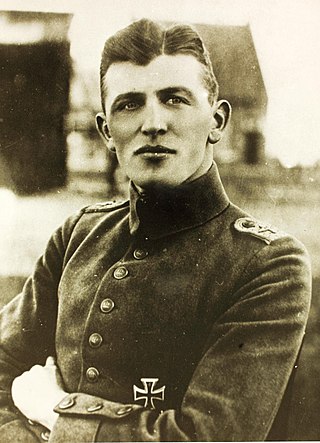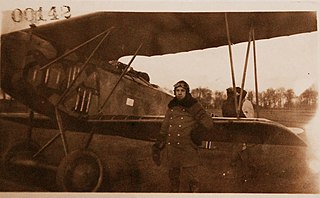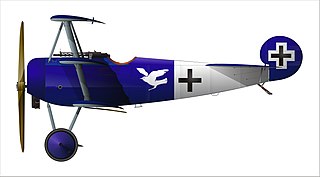Carl "Charly" DegelowPour le Merite, Royal House Order of Hohenzollern, Iron Cross, was a German fighter pilot during World War I. He was credited with 30 victories, and was the last person to win the military Pour le Merite.

OberleutnantHenrich Claudius Kroll Pour le Merite, Knight's Cross of the Royal House Order of Hohenzollern, Saxony's Albert Order Knight Second Class with Swords, Iron Cross First and Second Class, was a World War I fighter ace credited with 33 victories.
Generalmajor Hermann Frommherz Military Order of St. Henry, Royal House Order of Hohenzollern, Knight's Cross of the Military Karl-Friedrich Merit Order, began his military career in World War I as a German ace fighter pilot. He was credited with 32 victories. During World War II he was involved in the German takeover of Czechoslovakia and rose to become a Luftwaffe Generalmajor.
Paul Billik was a German World War I fighter ace credited with 31 victories. He was killed in a flying accident while pioneering civil aviation.

Adolf Ritter von Tutschek (16 May 1891 – 15 March 1918) PlM, MOMJ was a professional soldier turned aviator. As German air strategy turned towards concentrated air power, he was entrusted with one of the world's first fighter wings.
Generalmajor Otto Fruhner MMC, IC, was a German World War I flying ace credited with 27 victories. He was one of the first aviators to parachute from a stricken aircraft.

Leutnant Karl Thom, was a German World War I flying ace credited with 27 victories. He was decorated with both his nation's highest decorations for valor, the Military Merit Cross as an enlisted soldier, and the Pour le Mérite after he was commissioned as an officer. He was one of only four German aces of World War I to achieve this double award.

Leutnant Georg von Hantelmann was a German fighter ace credited with winning 25 victories during World War I. It was notable that these victories included three opposing aces shot down within the same week in September 1918–David Putnam, Maurice Boyau, and Joseph Wehner.
Leutnant Fritz Höhn was a German World War I fighter ace credited with 21 victories. He had worked his way up to being a fighter squadron commander and was eligible for the German Empire's highest award for heroism, the Blue Max, when he was killed in action on 3 October 1918.
Leutnant August Delling was a German World War I flying ace credited with five aerial victories.
Leutnant Ludwig Hanstein HOH, Bavaria's MMO was a World War I flying ace credited with 16 aerial victories.
LeutnantKarl Odebrett was a German World War I flying ace credited with 16 aerial victories.
LeutnantWilhelm Anton Seitz was a German World War I flying ace credited with 16 aerial victories. He scored those victories over a two-year span, beginning on 17 November 1916 and ending on 4 November 1918.
Hans-Georg von der Marwitz was a German World War I flying ace credited with 15 aerial victories.
Major Theodor Quandt was a World War I German flying ace credited with 15 aerial victories. He would return to his nation's service for World War II, being killed on 6 June 1940 during the Fall of France.
Leutnant Hans von Keudell was a World War I flying ace credited with twelve aerial victories.

Royal Prussian Jagdstaffel 15, commonly abbreviated to Jasta 15, was a "hunting group" of the Luftstreitkräfte, the air arm of the Imperial German Army during World War I. The unit would score over 150 aerial victories during the war, at the expense of seven killed in action, two killed in flying accidents, three wounded in action, one injured in a flying accident, and two taken prisoner of war.

Royal Prussian Jagdstaffel 12 was a World War I "hunting group" of the Luftstreitkräfte, the air arm of the Imperial German Army during World War I. As one of the original German fighter squadrons, the unit would score 155 aerial victories during the war, at the expense of seventeen killed in action, eight wounded in action, and one taken prisoner of war.
OffizierstellvertreterRobert Heibert was a German flying ace during World War I. He was credited with 13 confirmed aerial victories; he also had seven unconfirmed claims.
Oberst Paul Aue was a World War I flying ace from the Kingdom of Saxony in the German Empire. Partial records of his early aviation career credit him with 10 aerial victories. He would join the nascent Luftwaffe during the 1930s and serve Germany through World War II. He died in a Russian prison camp in 1945.





